NORTH WALES COAST
RAILWAY: NOTICE BOARD
Rheilffordd arfordir gogledd Cymru: Hysbysfwrdd
14 March 2011
 Last issue
Last issue Archive
Archive Contributions and comments are encouraged: see the Contributions Page
This site is dedicated to all our regular contributors and supporters, and especially the all rail staff of North Wales.
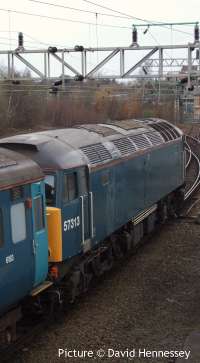
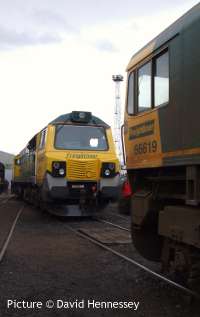
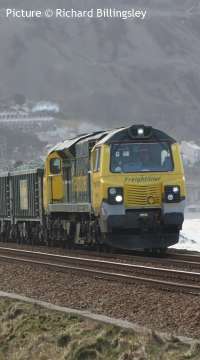
Forthcoming events
March 2011
Monday 21 March RCTS Chester Paul Chancellor FROM BLUE AND GREY TO BLACK AND GREEN. Paul from Colour-Rail presents slides illustrating the wide variety of liveries that have adorned British steam, diesel and electric locomotives over the past 60 years.
Thursday 31 March Merseyside Railway History Group AGM: Members Slides
April 2011
Friday 1 April Clwyd Railway Circle Geoff Morris: The Railways of South-West Wales over the last 30 years. A photographic journey looking at the railway scene in Pembrokeshire, Carmarthenshire and West Glamorgan, an area often neglected by the railway enthusiast. We visit far-flung outposts of the passenger system (Fishguard Harbour, Milford Haven, Pembroke Dock, Central Wales line) and also meet some unusual diesels (cut-down classes 03 & 08) on the way.
Monday 4 April RCTS Port Sunlight BRANCH AGM (Members Only) Followed by Members' Photographs.
Friday 8 April Altrincham Electric Railway Preservation Society
TORNADO - A STEAM LOCOMOTIVE FOR THE 21ST CENTURY
illustrated presentation by Graham Nicholas (A1 Steam Locomotive Trust)
Thursday 14 April Llandudno and Conwy Valley Railway Society
"We built the Railway" An interesting talk by Dafydd Thomas and a colleague on the engineering
tasks that were required to complete the Welsh Highland Railway through the
Aberglaslyn Pass and into Porthmadog.
Monday 18 April RCTS Chester Geoff Morris: ANOTHER AUSTRALIAN ADVENTURE. A digital presentation of Geoff’s 2010 visit to Australia featuring main line & preserved steam in Victoria, New South Wales & Queensland plus views of the modern scene and the odd kangaroo!
Thursday 28 April Merseyside Railway History Group Richard Kells: Quiz and informal evening
May 2011
Thursday 12 May Llandudno and Conwy Valley Railway Society
A presentation by Paul Lewin, General Manager, FR/WHR on the current
operations of these two fascinating railways.
Thursday 12 May Steam at Chester 'The Cathedrals Explorer' Steam Dreams Oxenholme - Carmarthen via Chester - Shrewsbury - Llandrindod.
Friday 13 May Excursion 'The North Wales Scotsman' Compass Tours Holyhead, Llanfairpwll, Bangor, Llandudno Junction, Colwyn Bay, Rhyl, Flint & Chester to Dundee via the Forth & Tay Bridges.
June 2011
Sunday 19 June Steam on the Coast: Northern Belle Father's Day Special. Crewe-Holyhead and return with 46201 Princess Elizabeth.
See the Calendar page for more details and later dates.
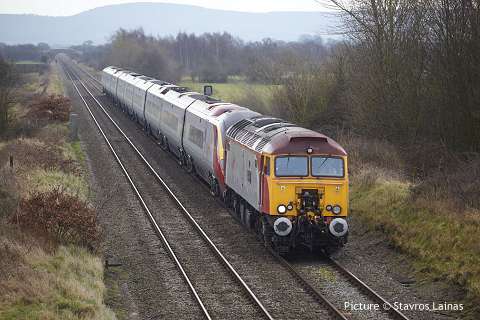
57 304 Gordon Tracy passes Waverton at 11:07 with the Saturday London - Holyhead train on 12 March, formed of 390 010 A Decade of Progress. Picture by Stavros Lainas.
Rugger Special
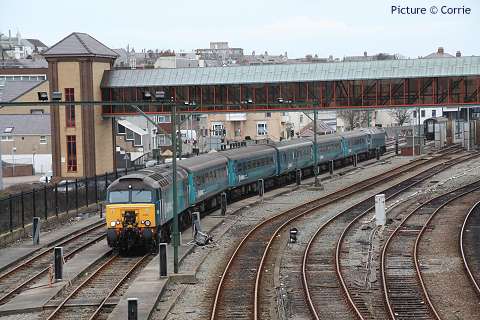
On the occasion of the 'Six Nations' rugby match in Cardiff between Wales and Ireland on 12 March, Arriva Trains Wales ran a loco-hauled special from Holyhead (departing 10:20) to Cardiff. It was formed of five of ATW's fleet of Mk2 coaches, hauled by 57 315, with 57 313 'dead' on the rear. Two extra coaches had been added the previous night to the regular train from Cardiff; the restaurant car remained on the touchline at Holyhead for the weekend. Above is the train in the carriage sidings at Holyhead ...
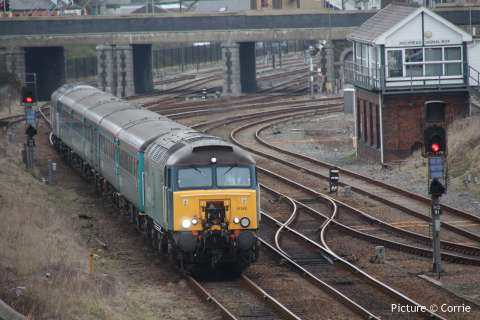
... and drawing forward out of the station ...
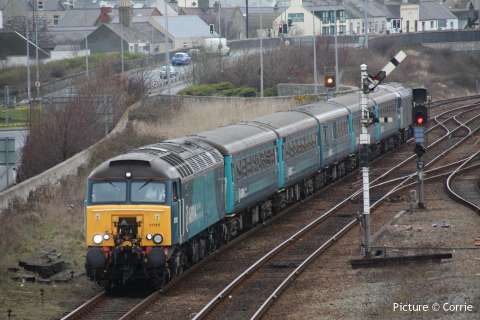
... and setting back ...
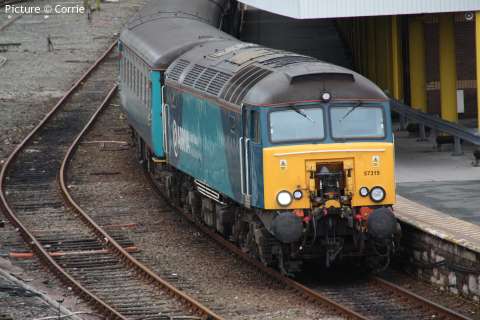
... into platform 1 ...
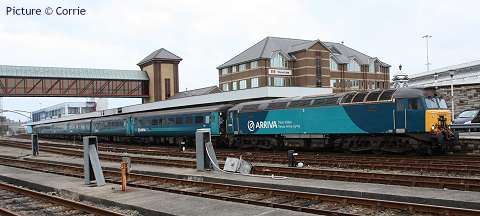
... ready for the kick-off.
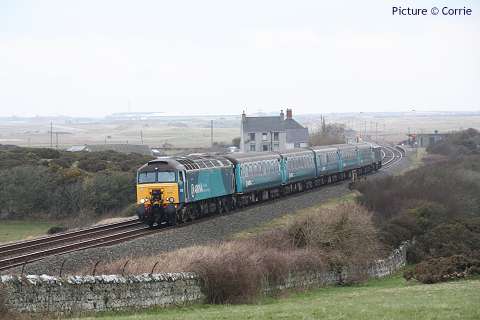
On the line out of Holyhead, and passing through a light shower of rain at Llanfaelog. Rhosneigr station is in the background, its information screens glowing brightly. All pictures above by Corrie.
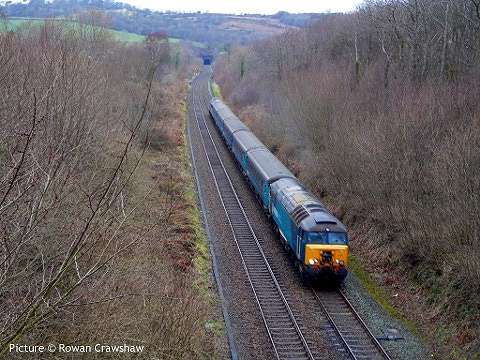
The two locos and five coach train pass Llandegai, east of Bangor (Rowan Crawshaw)
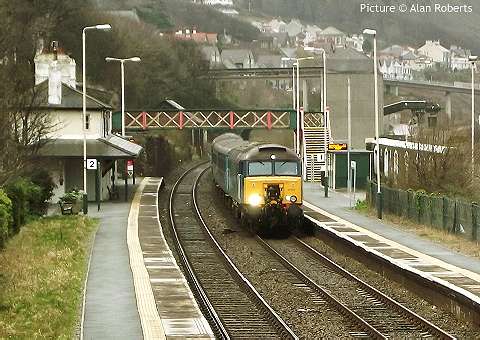
The view of special 1V41 from Penmaenmawr signalbox, as seen by signaller Alan Roberts.
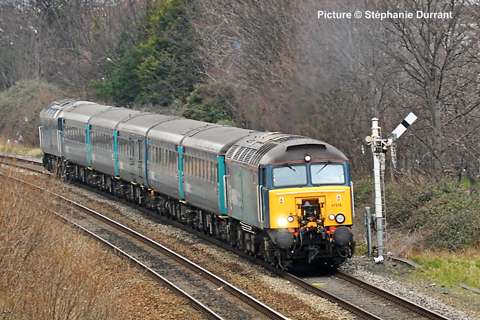
Approaching Rhyl (Stéphanie Durrant)
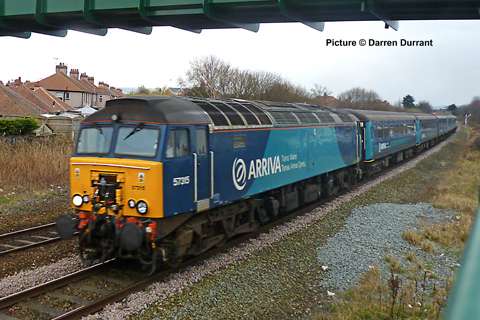
A few seconds later (Darren Durrant)
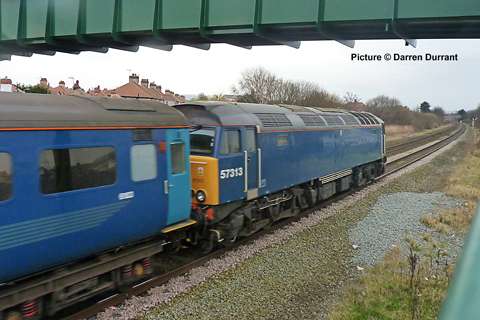
57 313 on the rear (Darren Durrant)
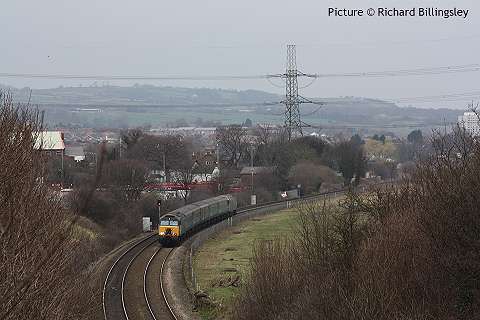
Passing Oakenholt, east of Flint (Richard Billingsley)
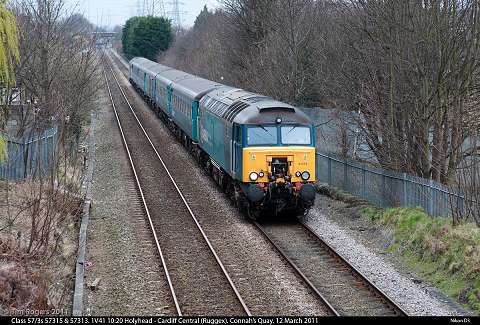
Connah's Quay (Tim J. Rogers)
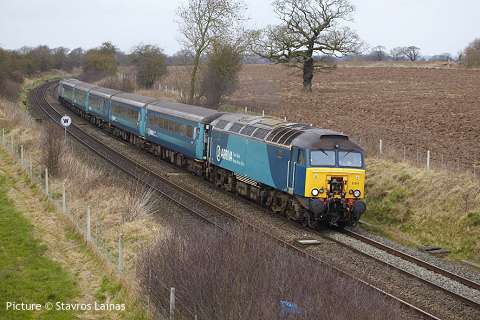
Calveley, between Chester and Crewe (Stavros Lainas). We hear that this train was not exactly besieged by a scrum of passengers: no doubt many had been deterred by ATW's assurance that there would be no trains running that day due to a strike, and the national office of union Aslef's statement (see last issue) that although the company had made a better offer, the strike had to continue until a vote could be held. However, a couple of days before the planned strike it was decided, we believe by union representatives at Company level, that the industrial action would be cancelled even though no vote was taken. Also, when ATW run these trains they don't seem to try very hard to publicise them to prospective users.
Puzzle: how many rugby terms can you find in the above article? Answer at the bottom of the page...
'WAG 2' Official Statement
Title: Second Fast North-South Rail Link
Date: 9 March 2011
By: Ieuan Wyn Jones, Deputy First Minister and Minister for the Economy and Transport
In 2008 I funded the introduction of 'Y Gerallt Gymro' express Holyhead to Cardiff service. This flagship service is key to delivering our 'One Wales commitment to reduce journey times between North and South Wales. It has proven to be very popular and has strengthened economic links between the north and south of the country.
I have now decided to introduce a second express train service, from May 2011, Monday – Friday, initially using a Class 175 train. This service will compliment the existing Y Gerallt Gymro service and has competitive journey times considering the current infrastructure constraints. The train will depart from Holyhead at 07:51 and arrives in Cardiff at 12:08. The return journey will leave Cardiff at 18:18 and arrives in Holyhead at 22:34.
I am aware that, as we have been preparing these proposals, that some Members, and Council Leaders, have expressed concern to me that the service would not call at stations on the North Wales Coast, or at Wrexham.
I am now able to confirm that the train will be able to stop at Wrexham in both directions. The morning train will call at Holyhead, Bangor, Llandudno Junction, Colwyn Bay, Rhyl, Chester, Wrexham, Ruabon, Chirk, Gobowen, Shrewsbury, Newport and Cardiff. The evening train after departure from Cardiff will stop at Newport, Abergavenny, Hereford, Shrewsbury, Gobowen, Ruabon, Wrexham, Chester, Rhyl, Colwyn Bay, Llandudno Junction, Bangor and Holyhead. This is the optimum journey pattern that is achievable within the overall target of journey times between Holyhead and Cardiff, via Wrexham, of some 4 hours and 17 minutes.
In order for the second express service to be able to call at Wrexham General Station in the morning I have asked Arriva Trains Wales to reroute the 07:15 Holyhead – Birmingham International service via Crewe instead of Wrexham. It would otherwise not be possible for the second express service to call at Wrexham due to the infrastructure constraints of the single track between Wrexham and Chester. This means that the 07:15 Holyhead – Birmingham International service can no longer call at Ruabon, Chirk and Gobowen. Therefore the new express service will call at these stations in order to avoid what would otherwise be a two hour gap in the mornings. Passengers for Birmingham joining from these stations will be able to complete their journey by changing and connecting into the 07:15 Holyhead – Birmingham service at Shrewsbury.
The Class 175 service will have an enhanced at seat trolley service including some hot food.
From the timetable changes in December 2011, the Class 175 train will be replaced by a Class 67 locomotive with carriages similar to those used on Y Gerallt Gymro. This service will be able to have a first class carriage and dining facilities similar to those currently available on Y Gerallt Gymro. I am funding a substantial refurbishment before these carriages are brought into service.
I remain committed to pathing the original 'Y Gerallt Gymro' service via Wrexham rather than Crewe. The study I am funding Network Rail to undertake, to improve the railway infrastructure between Holyhead and Cardiff, will be completed by the end of April. It will include consideration of options for capacity enhancements on the line between Chester and Wrexham with the objective of both a step change reduction in journey times for all services and of routing the express return service via Wrexham. I expect construction work to commence next year.
As this term of Government ends, I believe that I have taken firm steps to improve transport provision between North and South Wales. This is important for the economy of our country and improving journey times for passengers.
Locomotive variety - report by Richard Billingsley
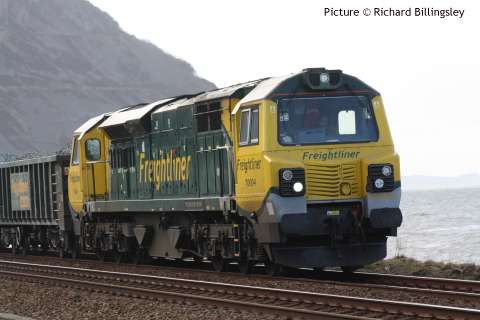
Freightliner provided a rare outing for a class 70 onto the Coast on 10 March, 6D22 empties from Basford Hall - Penmaenmawr and 6K56 return were hauled by recently named 70 004 The Coal Industry Society. It is seen above alongside the A55 at Penmaenmawr, with the ever-depleting mountain behind.
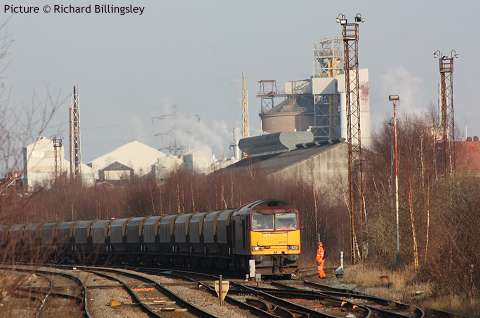
Over on the mid-Cheshire, the Tunstead - Brunner Mond limestone continues to solidly produce Mirrlees power, on 6 March it was the turn of 60 045 to power 6F05, seen alongside the Brunner Mond complex ...
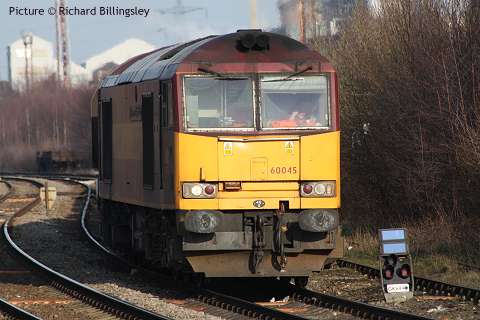
... and reversing the train in from Northwich station.
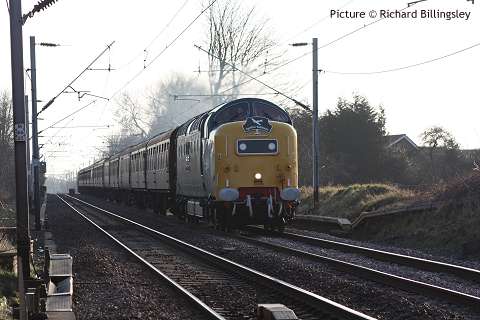
A quick dash, after 'photting' the class 60, over to Holmes Chapel, and as I walked onto the platform, a familiar hum could be heard in the distance. Soon after, the final Euston - Preston leg of the 50th birthday tour for Royal Scots Grey appeared round the corner. Maybe a little over-painted, but 55 022 makes a stirring sight approaching the station. [See also last issue.]
RCTS news - by Richard Neale
The Railway Correspondence and Travel Society meets at the Town Crier opposite Chester railway station on Monday 2March at 7.30 p.m.
Our speaker is Paul Chancellor from Bromsgrove with a colour slide presentation entitled 'From Blue and Grey to Black and Green.' Paul is now the proprietor of the Colour Rail who supply many railway colour slides from the past 60 years to members of the general public.
Visitors are more than welcome to attend this meeting but with a £2 voluntary donation. Such donations enable the Society to continue its regularity of such meetings. Further inquiries about this meeting can be made by telephoning 0151 - 608 4296.
The Sealand Story
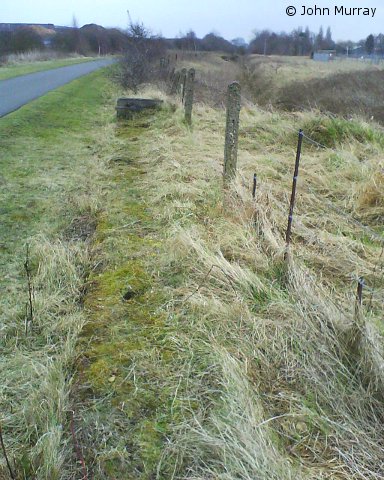
Following John Murray's article in the 28 February Notice Board concerning the remains of narrow-gauge tracks at the Sealand RAF camp (picture above) we received some interesting correspondence from people who know the area well. The rails and 'buffer' are the remains of the second level crossing that existed at this location. This crossing was to enable larger/heavier aircraft to cross the former Great Central Railway Chester Northgate to Dee Marsh line (now a cycleway) to access the concrete runway on West Camp (now the industrial estate, still with quite a few RAF buildings still in use) from the workshops on the currently-mothballed South Camp.
As conventional gates could not be used, two large sliding gates, running on rails, were made and fitted each side.
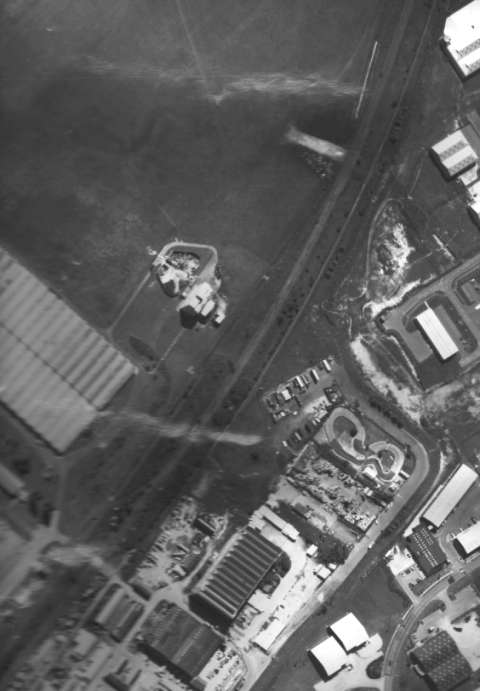
The above aerial view (supplied by 'Railman' from his collection) shows the vehicle crossing at the bottom left with the aircraft crossing to the top right. The former ramp is still there on the South Camp side, whilst the industrial estate side cleared completely.
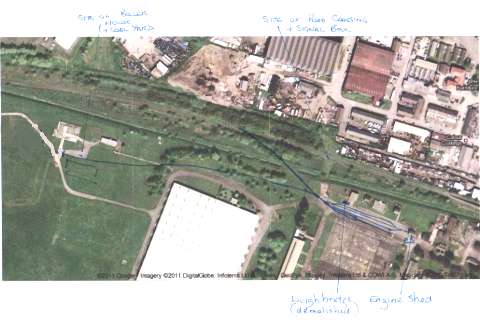
However, there was standard gauge at Sealand: two separate systems in fact. These illustrations and notes kindly created by 'Railman' show the location of the tracks as they were, superimposed on a present-day Google map. South Camp (above) had a set of sidings to serve the then coal-fired boiler house which was halfway between the road and aircraft crossings (the big building just off centre in the aerial view), its own engine shed and diesel shunting loco.
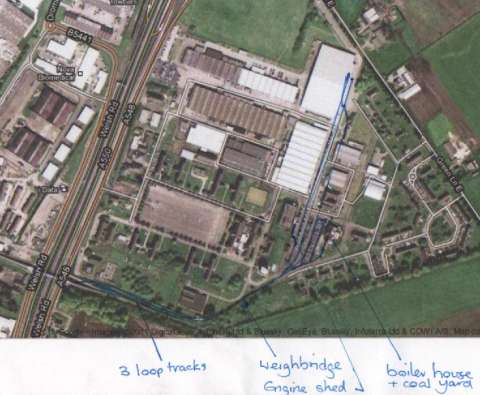
East Camp had a set of sidings which started immediately after the bridge carrying the line over the A550 road. These served another boiler house, and also the storage / repair depot this was built in the 1930s and its rail connection provided at that time. There was another engine shed and diesel shunting loco.
Thanks also to Martin Baugh, who writes: 'With reference to the 'Sealand narrow gauge mystery' alongside Marsh Road. I used to live further down the road, in what were known as Marsh Cottages. I believe the rails were part of the gates that controlled crossing of aircraft over the railway line during World War 2. Up to the late sixties the gates were in situ. They were steel, on pulley wheels that ran on those rails.
'The freight that arrived at the camp was always part of a freight to Shotton Steelworks, tripped by a 08 to Sealand station, where when the 08 parked the wagons into siding the RAF diesel would collect and sort the wagons and sort. The line from Chester had some fantastic
trains hauled by 8F and 9Fs: I also remember the introduction of diesels bringing oil into Shotton Steelworks. Marsh Cottages were demolished to make way for the head office of Iceland stores - hence I have never been in one of their shops.'
Thanks to that marvellous book by V.J. Bradley, Industrial Locomotives of North Wales (Industrial Railway Society 1992) we can tell you something about the standard-gauge locos which worked at RAF Sealand. Shotwick Aerodrome was first established during World War I, re-named Sealand in 1924 - apparently to avoid confusion with another RAF station in Lincolnshire called Scopwick. In 1951 it was transferred to the control of the United States Air Force (see the RAF Burtonwood website) until it returned to British service as the Royal Air Force Maintenance Unit in 1957.
The first loco at Sealand was an old steam 0-4-0 saddle tank named Torcross but from 1938 onwards diesel shunters were obtained. Four 0-4-0 150 HP diesel-mechanical shunters built by the John Fowler company numbered AMW 149, 170, 223 and 245 arrived between 1938 and 1943; and there was also a four-wheel 88 HP Ruston & Hornsby machine numbered 238 which worked from 1943, which we believe still exists, preserved at the West Somerset Railway. Rail traffic ceased around 1971; of the Fowler diesels, 149 was transferred in 1968 to the air base at Burtonwood, near Warrington, whilst after the cessation of rail traffic the other three were moved to Crump's Connahs Quay wagon works, where they were scrapped in 1973.
See Dave Sallery's website for some interesting scenes of the last days of the Chester - Hawarden Bridge line, including a glimpse of the remains of the Sealand sidings.
An outing to Crewe - with David Hennessey
Here are some images taken from my outing to Crewe on 12 March.
The first one (above) is of Virgin 57 304 Gordon Tracy gearing up to work the morning Holyhead Pendolino drag to Holyhead (390 010 A Decade of Progress was the unit dragged).
At the Crewe Heritage Centre, there was a Charity weekend for Emmie Dixon Home, Crewe, featuring guest locomotives from Freightliner. Above, 66 619 Derek W Johnson MBE.
Above, recently-delivered loco 70 011. [For more about the Crewe charity event, including a visit to the Advanced Passenger Train, we recommend Vince Chadwick's blog.]
Finally, seen from the viewing area on the preserved Crewe North Junction signalbox is an engineer's train heading out of Crewe onto the Chester line top-and-tailed by 66 138 ...
... and 66 165.
Answers to the rugby puzzle: match, touchline, kick-off, forward, back, line out, try, scrum. No prize, even if you find more!
North Wales Coast home page Archive Previous Noticeboard